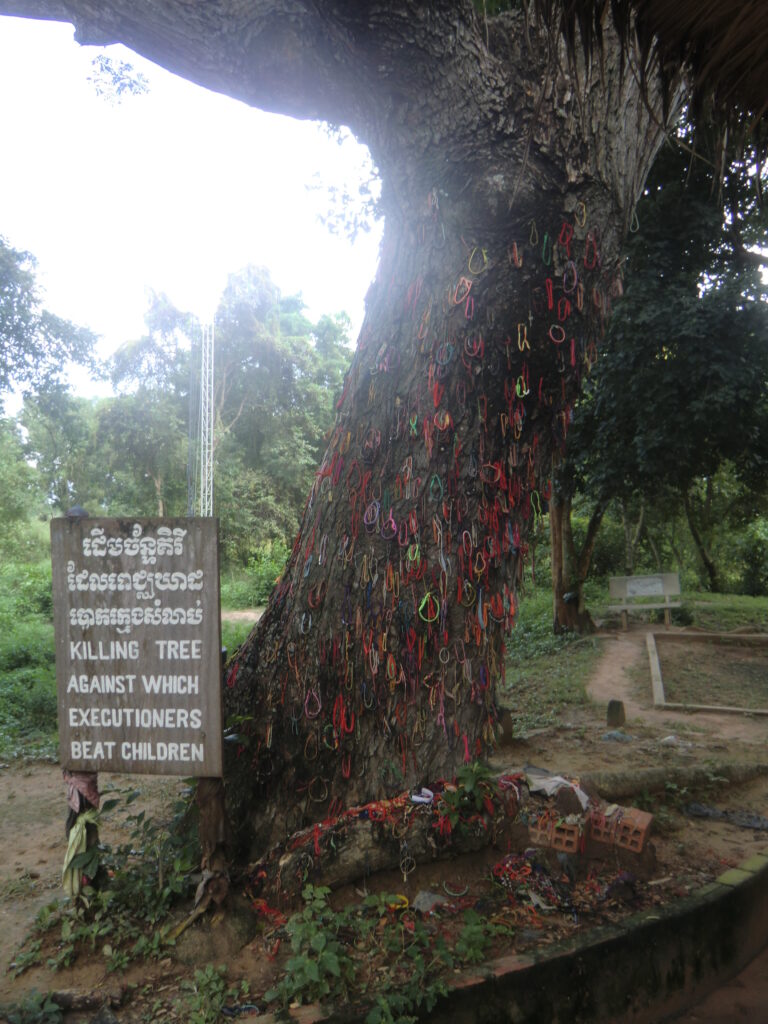Arriving in Cambodia I was surprised at how happy I was to be out in the tuk tuk moving through Phnom Penh to the hostel, delighting in sights such as street food and the sheer number of scooters ducking and diving through every gap in the road. I was delighted to find a new record of six people on a scooter (two adults, four children). With less street food and more four wheeled vehicles in the Philippines, I realised I had become quite fond of these vistas and had missed them during my few weeks away.

At first view, Cambodia feels like a more relaxed, friendlier version of Vietnam. Having the added bonus of being able to amaze me with something as simple as a street sign, due to their beautiful alphabet which looks to me more like art than writing.
The first full day here was an emotional one. I shared a tuk tuk with three others from my hostel to the Killing Fields. We were each given our own headset to listen to as we walked around what is now the memorial grounds, but was then a location for execution and disposing of the bodies. Stories of the graphic ways in which they were killed (generally bludgeoned to death in some way as bullets were expensive) and hearing the sheer number of people that were murdered was quite overwhelming. Around three million people were killed in three and a half years. One in four people in the country. These were men, women, children and babies. If one member of a family was killed, it was likely this fate would be the same for the rest of the family to ensure no one lived to exact revenge.

We were told Pol Pott had many slogans for his campaign, one in particular which stuck in my memory was ‘It is better to kill an innocent by mistake, than let an enemy live by mistake’.
Near the end of the tour, music was played which would have been used during the killing days to help drown out the screams of people being tortured and killed. It is likely the last thing many people heard. As I listened to this play I slowly walked back to the central memorial area, as I did so, I noticed several rags half buried in the ground. These would have belonged to victims that were buried there. Clothes, bones and teeth continue to rise to the surface to this day, the rainy seasons causing them to be pushed out of the ground.
It is a hard reality to digest. Seeming quite impossible that this was able to happen, and in such recent history. It is likely that everyone in this country knew someone who was a victim or who was in some way connected. Yet when you walk around the streets, and meet people here, it is hard to believe it ever occurred. These people seem happy, friendly and really determined to continue to work hard and move forward in a positive light. It really is an inspiring country.
My second day in Phnom Penh was less emotional but still very educational. I saw the Palace, an array of impressive buildings, temples and statues, and is still the residence of Cambodia’s King. I also viewed the National Museum, which had an impressive exhibition detailing events from the pre-Angkor, Angkor and post-Angkor periods of history. This helped to explain the religious and spiritual links the country holds with both Buddhism and Hinduism.
Finally, I made my way to the Central Market. It was great here, a vibrant place buzzing with activity yet not overcrowded. The main building was centralised around a dome shape with several arms extending out into different sections. Along with the usual market trends there were souvenirs and trinkets made from silver and wood and many jewellery stands selling silver within the dome, giving the place a more upmarket feel. The selling style was very different from the Vietnamese, although I was sometimes approached by sellers, I never felt pressured or harassed. I didn’t stay long however, as I managed to buy two pairs of trousers in the first fifteen minutes and was worried I would find more to buy if I lingered!



Had to look up the definition of ‘tuk tuk’ … ‘a three-wheeled motor vehicle used as a taxi’ (Thailand).
Reading about your visit to The Killing Fields certainly brought a lump to my throat. I doubt that is something you’ll forget very easily. Those poor poor people…
Enjoyed our Skype chat yesterday … very nice new trousers you showed me. You certainly got a bargain there. 🙂
Lots of love xxx
An experience I’m sure you will never forget Nicki, helps us put everything in perspective.
Sounds like Cambodia is another amazing experience, I’m so pleased that you’re living your dream. We’re living it also through you.
Dad x x x x
Await your next blog, so glad your enjoying it. X